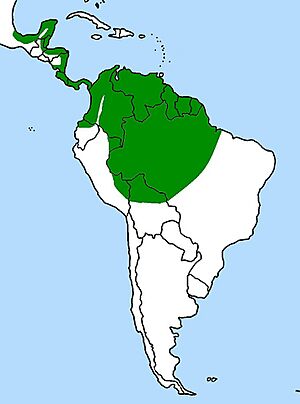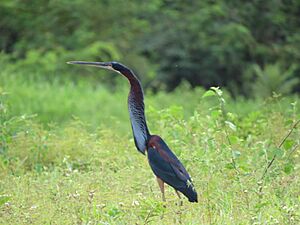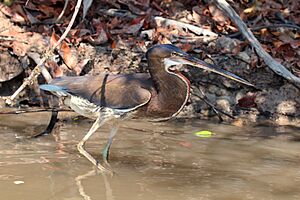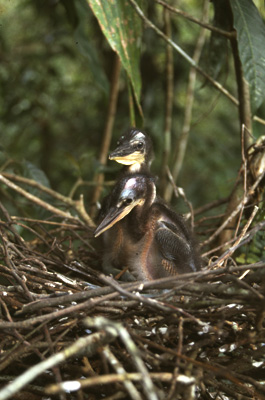Agami heron facts for kids
Quick facts for kids Agami heron |
|
|---|---|
 |
|
| Adult in Costa Rica | |
| Conservation status | |
| Scientific classification | |
| Genus: |
Agamia
|
| Species: |
agami
|
 |
|
| Global range | |
The agami heron (Agamia agami) is a beautiful, medium-sized bird. It belongs to the heron family. This bird lives in the warm, wet areas of Central and South America. It is sometimes called the chestnut-bellied heron because of its pretty colors. In Brazil, it has a special name, Soco beija-flor. This means 'hummingbird heron', because its feathers are so colorful. It is the only species in its group, called Agamia.
Sadly, the agami heron is listed as Near Threatened by the IUCN. This means it might be in danger. Its home, the forests and wetlands, are predicted to be destroyed in the future.
Contents
About the Agami Heron's Name
The agami heron was first officially described in 1789. This was done by a German scientist named Johann Friedrich Gmelin. He gave it the scientific name Ardea agami. The name agami comes from a word used by people in French Guiana. It is the name for a bird called the Grey-winged trumpeter. The agami heron is the only species in its special group, or genus, called Agamia.
What Does the Agami Heron Look Like?
This unique bird is about 66 to 76 centimeters (26 to 30 inches) long. It has shorter legs than most herons. Its bill is very thin and long. It is much longer than its head.
The heron's neck and belly are a rich chestnut color. It has a white line down the front of its neck. Its wings are a shiny green color. Pretty pale blue feathers decorate its head and lower back. The legs, bill, and a bare patch on its face are dull yellow. When it's time to breed, the facial patch can turn reddish. Both male and female herons look similar. Young herons are mostly brown on top. They have a white front neck and streaky brown and white underparts. They usually lay two blue eggs.
The agami heron's bill is about 15 centimeters (6 inches) long. This very long bill helps it catch prey from a distance. It can strike food farther away than other herons with shorter bills.
Where Do Agami Herons Live?
The agami heron lives in Central and South America. You can find it from southern Mexico all the way through the Amazon basin. This includes countries like Mexico, Costa Rica, Panama, Colombia, Peru, Bolivia, and Brazil.
These birds do not like open spaces. They prefer swampy forests and mangrove areas. They also live near forest streams and freshwater wetlands. They usually live at low elevations, close to sea level. However, some have been seen high up in the Andes mountains.
Agami herons build their nests in groups. They make platforms of sticks in bushes and trees over water. Some of these nesting places are very large. They can have hundreds or even over a thousand nests!
How Do Agami Herons Behave?
Even though this bird is stunning, it is rarely seen. This is because it likes to stay hidden in the shade. It also prefers places with lots of plants hanging over the water. The agami heron is usually a quiet bird. But groups of them might make snoring or rattling sounds. If they are disturbed, they often make rattling sounds and walk away slowly.
Agami herons hunt for their food in shallow, shaded water. They look for fish, frogs, small reptiles, and snails. They often stand very still on branches or in the water. Sometimes they move very slowly. They rarely wade in open water. A study in 1985 found that they mostly eat small fish, about 2 to 10 centimeters long.
During courtship, both male and female herons show off. Their facial patches can turn a bright red color. They also show a shiny, silver crest on their heads for a short time.
Protecting the Agami Heron
The agami heron is a very private bird. Scientists do not know much about it. This makes it hard for people who work to protect animals. Its hidden home and shy behavior might make it seem rarer than it is.
However, the IUCN Red List still considers it near threatened. This is because its habitat in the Amazon is expected to be lost in the future. To help these birds, we need to protect their important nesting sites. We also need to learn more about where they live and what they need to survive.





